In today’s fast-paced world, maintaining optimal health is a priority, and one often overlooked aspect is how food can help regulate body temperature. Body cooling foods offer a natural way to stay refreshed, especially during hot weather or intense physical activity. This blog explores what body cooling foods are, their types, benefits, simple recipes, and precautions to ensure you make the most of them. With a focus on hydration, nutrition, and temperature regulation, these foods are a delicious and healthy addition to your diet.
What Are Body Cooling Foods?
Body cooling foods are natural ingredients that help lower body temperature by promoting perspiration and hydration. These foods trigger the body’s thermoregulatory system, encouraging sweat production, which cools the skin through evaporation. Common examples include watermelon, cucumbers, and mint, which are packed with water and nutrients to keep you refreshed.
How Do Body Cooling Foods Work?
The science behind body cooling foods lies in their ability to stimulate sweat production and hydration. When consumed, these foods activate receptors that signal the brain to produce sweat, which evaporates and removes heat from the body. For instance, foods like ginger and mint enhance circulation and provide a cooling sensation, making them ideal for hot days.
Why Are Body Cooling Foods Important?
Incorporating body cooling foods into your diet is essential for maintaining comfort and health, particularly in warm climates or during physical exertion. These foods help prevent overheating and reduce the risk of heat-related conditions like heat exhaustion or heat stroke. Beyond temperature regulation, they offer vital nutrients like vitamins, minerals, and antioxidants, supporting overall well-being.
Benefits of Body Cooling Foods
- Temperature Regulation: These foods lower body temperature, keeping you comfortable in hot weather.
- Hydration Boost: High-water-content foods like watermelon and cucumber keep you hydrated.
- Nutrient-Rich: Many cooling foods, such as citrus fruits and leafy greens, are packed with vitamins and antioxidants.
- Immune Support: Ingredients like oranges provide vitamin C, strengthening immunity.
- Energy and Electrolytes: Coconut water, for example, replenishes electrolytes, keeping you energized.
Types of Body Cooling Foods
Body cooling foods can be broadly categorized into fruits and vegetables, and herbs and spices. Each offers unique properties to help you stay cool and healthy.
Fruits and Vegetables for Cooling
Nature provides a variety of fruits and vegetables with cooling properties:
- Watermelon: With 92% water content, watermelon is a hydrating, sweet option for cooling down.
- Cucumbers: Their crisp texture and high water content make them a refreshing snack.
- Citrus Fruits: Lemons and oranges provide a cooling effect and are rich in vitamin C.
- Leafy Greens: Spinach and kale are nutrient-dense and help regulate body temperature.
- Berries: Strawberries and blueberries offer antioxidants and a cooling, sweet treat.
Herbs and Spices with Cooling Effects
Herbs and spices can enhance meals while providing cooling benefits:
- Mint: Known for its refreshing sensation, mint cools the body when added to drinks or dishes.
- Coriander: This herb has cooling properties and adds flavor to various cuisines.
- Fennel Seeds: With a licorice-like taste, fennel seeds aid digestion and cool the body.
How to Incorporate Body Cooling Foods into Your Diet
Adding body cooling foods to your daily meals is simple and delicious. These foods are versatile, nutrient-packed, and perfect for hot days or post-workout recovery.
Simple Recipes for Cooling Foods
Here are three easy recipes to enjoy body cooling foods:
- Watermelon Cucumber Salad
- Ingredients: Diced watermelon, sliced cucumber, mint leaves, lime juice.
- Instructions: Toss ingredients together and drizzle with lime juice for a refreshing summer salad.
- Why It Works: Combines hydrating watermelon and cucumber with cooling mint.
- Berry Mint Smoothie
- Ingredients: Mixed berries (strawberries, blueberries), spinach, mint, and almond milk.
- Instructions: Blend until smooth for a nutrient-rich, cooling drink.
- Why It Works: Berries and spinach provide antioxidants, while mint adds a cooling effect.
- Frozen Grape Snack
- Ingredients: Grapes or berries.
- Instructions: Freeze for a few hours for a sweet, cooling treat.
- Why It Works: A quick, sugar-free snack to cool down instantly.
Tips for Choosing Cooling Foods
- Opt for Fresh and Organic: Seasonal produce is fresher, tastier, and more nutrient-dense.
- Diversify Your Plate: Include a variety of colors and textures for a range of nutrients.
- Consider Dietary Needs: Choose foods that align with your preferences and health goals.
- Experiment with Flavors: Combine fruits, vegetables, and herbs for exciting, cooling dishes.
Health Benefits of Body Cooling Foods
Beyond keeping you cool, these foods offer a range of health benefits that enhance overall wellness.
Temperature Regulation
The primary advantage of body cooling foods is their ability to stabilize body temperature. By promoting sweat and hydration, they prevent discomfort and heat-related illnesses, making them essential for summer or intense workouts.
Additional Health Benefits
- Hydration: Foods like watermelon and coconut water keep you hydrated, supporting bodily functions.
- Nutrient Boost: Leafy greens and citrus fruits provide essential vitamins and minerals.
- Antioxidant Power: Berries and other cooling foods combat oxidative stress, promoting long-term health.
- Digestive Health: Herbs like fennel and coriander aid digestion, reducing discomfort in hot weather.
Precautions When Using Body Cooling Foods
While body cooling foods are generally safe, there are a few considerations to keep in mind to avoid potential side effects.
Potential Side Effects
- Overconsumption: Excessive intake of cooling herbs like mint may cause digestive discomfort in some individuals.
- Allergies: Be aware of any food sensitivities or allergies when trying new cooling foods.
- Balance: Too many cooling foods may lead to an overly cooling effect, especially in colder climates.
When to Avoid Cooling Foods
- Medical Conditions: Individuals with conditions like hypothermia or sensitivity to cold should consult a healthcare professional before consuming cooling foods.
- Moderation: Balance cooling foods with other dietary components to maintain overall health.
- Seasonal Awareness: Limit cooling foods in colder months to avoid feeling too chilly.
FAQs About Body Cooling Foods
What foods help cool the body? Fruits like watermelon, cucumbers, and citrus, along with leafy greens and herbs like mint and coriander, are excellent for cooling the body.
How do cooling foods work? They promote sweat production and hydration, which help regulate body temperature through evaporative cooling.
Can cooling foods prevent heat stroke? Yes, by maintaining hydration and regulating body temperature, they reduce the risk of heat-related illnesses.
Are there any risks to eating cooling foods? Overconsumption may cause digestive issues in some people, and those with certain medical conditions should consult a doctor.
What are some easy cooling food recipes? Try a watermelon cucumber salad, a berry mint smoothie, or frozen grapes for quick, refreshing options.
Conclusion
Body cooling foods are a natural and delicious way to stay refreshed, hydrated, and healthy, especially during hot weather or physical activity. From juicy watermelon to refreshing mint, these foods offer cooling benefits alongside essential nutrients. By incorporating them into your diet through simple recipes and mindful choices, you can beat the heat while supporting overall wellness. Just remember to consume them in moderation and consider any personal health conditions. Next time you’re feeling the heat, reach for these cooling foods to stay comfortable and energized!



